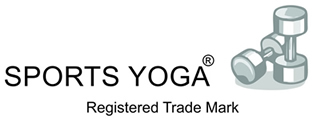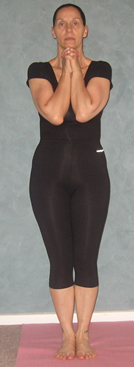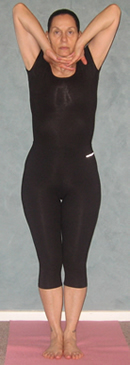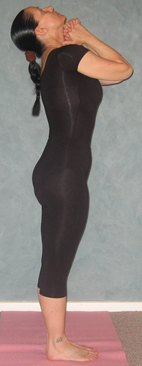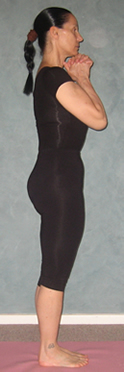Contact Us | 

PRANAYAMA BREATHING TECHNIQUE FOR SPORT PEOPLE
Pranayama Technique for Athletes
Standing Heating Breath (Bhastrika Pranayama)
New research in the Journal of Medicine and Science in Sports have established that Bhastrika Pranayama enhances lung function capacity and efficiency in athletes.
This is an empowering chest/thoracic type of breathing technique that has a very important place in hatha yoga. The Standing Heating Breath benefits are numerous, they range from physiological to postural, mental, psychological and emotional. This type of pranayama has been adopted by Bikram as part of the initial warm up sequence and as a mean to energize/detoxify the body in preparation of yoga practice consequently is now associate with hot yoga, however, this technique of forcefully and quick breathe in from nose and breathe out from mouth exists for centuries.
Blower in Sankrit is called Bhastrika. Hence exhalation of breath forcibly and quickly is the main feature of Bhastrika Pranayama. One should inhale and exhale breath like a blower. It is in a way a combination of Kapalbhati and Ujjayi. Among all the Kumbhakaras, this Pranayama is considered the best.
When to practice Standing Heating Breath?
Before any intense physical activity that requires your body to be warmed up. Warming up the muscles before any physical activity dramatically reduces the risk of injury. This breathing is very useful for athletes such as tennis players, swimmers, soccer players, dancers when practicing Sports Yoga® asanas.
Any time, any place you feel tired and need energy, practice the Standing Heating Breath and your vitality will come back.
HOW TO PERFORM STANDING HEATING BREATH TECHNIQUE
It is very important that it is done properly. Please, keep in mind that if at any point you feel dizzy or giddy or you might want to yawn, it is due to the sudden appearance of real oxygen in your blood which eventually gets to the brain. It is wise that you stop.
Step 1: Stand with feet together, toes pointing forward, big toes touching, heels touching. If this is uncomfortable, separate the feet up to hip distance width apart. Keep your weight mostly towards your heels, as opposed to the toes. Avoid leaning forward. Interlace the fingers and then push the knuckles firmly into the chin, keeping palms, wrists, forearms and elbows touching together. The knuckles will stay pushing firmly into the chin the whole time.
Step 2: Keeping the mouth closed, start inhaling through the nose to a count of 6. You are actually breathing through the throat constricting the glottis. You are making a Darth Vader sound or ocean sound. Simultaneously, as you inhale, you raise your elbows on either side of the head, but not the shoulders. The goal is for the elbows to someday touch the ears. Do not bend your wrists. Simultaneously, you lower the chin into the curve that your arms form. Do not bend forward, simply lower the chin.
Step 3: As soon as you have reached the count of 6, drop the head back, open up the mouth and let the exhalation begin out the mouth for a count of 6 as well. You are again making the Darth Vader sound or ocean sound at the back of the throat. Simultaneously, keeping the knuckles to the chin, you bring the wrists, forearms and elbows together and forward to meet in front of your face. Push upwards until you are looking straight at the ceiling.
Step 4: Once the exhalation to the count of 6 has finished and palms, wrists, forearms and elbows touch; bring the head back to centre.
The steps above describe a full inhale-exhale cycle. Repeat this cycle 10 times. At the end of the 10th cycle bring your arms alongside of your body and return to your regular breathing.
KEY POINTS OF THE WORKING MECHANISM OF THE STANDING HEATING
Remember that the size of the lungs follows the size of the chest. Anything which expands and contracts the chest it also expands and contracts the lungs through:
-
lifting or compressing the rib cage
-
lowering or raising the dome of the respiratory diaphragm
-
releasing or pressing inward with abdominal muscles
- allowing the elasticity of the lungs to draw-in chest wall
Three sets of muscles are active in normal breathing:
-
inter-costal muscles
-
abdominal muscles
- respiratory diaphragm
During proper Standing Heating Breath you keep enough tension in your abdominal muscles so that your lower abdomen is not expanding out during inhalation. This ensures that the upper part of the abdomen just below the sternum, the lower part of the chest, and your rib cage are all expanding in order to give room to the lungs to expand.
During proper Standing Heating Breath you are exercising the diaphragm in an isometric way. Its muscle fibres resist lengthening by keeping the dome of the diaphragm from being pulled freely towards the head as inhalation proceeds. At the peak of the inhalation, it holds momentarily in a state of isometric tension.
During proper Standing Heating Breath the position of the arms works together with the external intercostal muscles to increase the inspiratory capacity. Due to our sedentary lifestyle, we tend to use only a small percentage of our vital lung capacity. The increased heart rate creates pulmonary arterial pressures high enough to perfuse the entire lungs with blood at the same time they are being ventilated from top to bottom.
Do not go to extremes!
Standing Heating Breath carried to extremes will over-stimulate the sympathetic nervous system. An extreme situation is when you inhale so deeply that the abdominal wall moves in and when you exhale so hard that the abdominal wall moves out.
Cautions: The Standing Heating Breath should not be performed in case of pregnancy, heart disease and high blood pressure.
*Most yoga breathing exercises cannot be learned via the senses of an inexperienced person unfamiliar with the internal territory. This is why it is extremely important that only qualified people teach and practice them. You don’t need any special training or knowledge to practice them. Whether you are perfectly healthy or suffering from some illness, you can practice these exercises daily.
These are the best way to properly prepare for esoteric forms of yoga breathing exercises.
For more Articles, click > Yoga Articles
© Copyright ©2013 - 2019 Sports Yoga® - Registered Trade Marks owned or used by Sports Yoga | Trademark & Legal | Terms of Service
